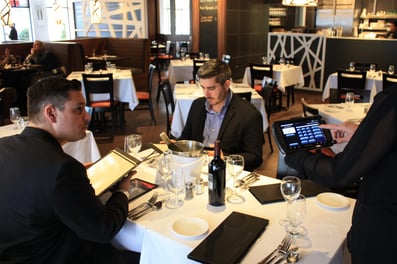Something funny happened in this year’s Hospitality Technology’s Restaurant Technology Study. We were left out. I don’t mean just “we,” Maitre'D. I mean “we” restaurant POS vendors. They didn’t include us in the study. Their reason: we’re still as a category the biggest line item in the budget, but we are ubiquitous—over 90% of the restaurants they studied in 2014 had core POS technology in place. HT has decided to only include restaurant POS systems every other year.
They make an important point. The value of POS is no longer in question—POS is essential for almost all of you. Today, the majority of POS vendors’ sales come from either replacing an existing POS, or adding new features to that POS.

HT then lists 19 technologies that are important for front of house automation, and another 15 for back of house. A point they make repeatedly is that there’s a shift from being operations-centric to being customer-centric. Away from streamlining operations and towards making customers happier.
We see that too. You’re transitioning from a tactical tech buyer to a strategic tech buyer—moving from nailing the basics of efficient operation to creating a technology infrastructure that supports your strategic initiatives for growth and profitability. You may be able to see this is in the way the conversation has shifted when you talk about technology and the return on tech investments. As a core POS buyer, your focus was on saving money. That’s what core technology does: inventory management, employee scheduling, menu management, sales reporting and forecasting, and so on. But once that’s in place you begin to think, talk and plan around growing revenue—around making money from your technology. Now you’re looking at ways to increase sales—new channels, new analyses, new payment methods, new integration with social media, new ways to offer loyalty programs and rewards . . . and others. That’s what advanced functionality does.
Technology has shifted from a tactical investment to a strategic one.
There’s a basic pattern, or cycle, of enhancement that POS implementations follow.
- You start with base technology—with your POS.
- You begin to enhance it with third-party solutions.
- As those solutions become available on the core POS, you transition.
- New functionality emerges, in new third-party systems.
In this respect, we’re like the auto industry. Many of the features on today’s cars began as third party products, then as part of option packages, and eventually just standard equipment.
This cycle won’t end anytime soon—maybe ever. The best restaurant technology systems will always contain a shifting mix of advanced functionality provided with the core POS, and emerging solutions from third party vendors. Over time you’ll see us (meaning: POS vendors in general) launch new functionalities that have the strongest intersection of our core competencies, market demand and potential profitability. Once it’s part of the POS, customers transition from their third-party system to ours. But we’ll never be able to provide it all—mainly because all is a constantly moving target. As soon as we launch, let’s just say a mobile wallet module, some innovative engineer is bringing wearables into the picture.
Third-party Integration makes this continual cycle possible, manageable and profitable. That’s why Maitre'D integrates with hundreds of applications and with virtually every standard database. Whether we’re talking about gamification or mobile payment systems, that integration is seamless and complete. Just to make sure I’m clear: integration is not about where you launch an application, it’s about how the data from all those applications is brought together, managed and made available for transactions, analyses, forecasting and more. Mobile wallet transactions are integrated into reporting. Social activity into loyalty and gift programs. Biometrics with labor management. And with this level of integration, the ultimate transition from third-party solutions to the integrated POS solution is simpler, easier and trauma-free.
As you emulate your strategic third-party enhancements to your core POS, I think this is something to keep in mind. How well and completely does it integrate with your POS? Workarounds not invited—it either does or it doesn’t. For that matter, it is also a good idea to evaluate your existing POS to determine that it has the ability to fully and functionality integrate with best-of-breed external solutions.
Solid integration both ways—core system and third-party enhancements—allows you the agility and flexibility to select the best customer-facing solutions for your business and your budget—and then easily integrate them with POS. And that’s how you can continually deliver the innovations your customers need and the data integration and visibility your operation demands.
That’s how you make your technology a strategic part of your business.

